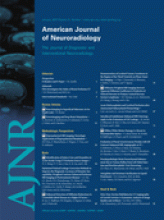Abstract
BACKGROUND AND PURPOSE: Region-of-interest (ROI) and tract-based diffusion tensor imaging (DTI) analyses have detected increased apparent diffusion coefficients (ADCs) and decreased fractional anisotropy (FA) in callosal and projection systems of adult patients with multiple sclerosis (MS). We explored whether similar changes occur in pediatric patients with MS, assessing 3 major white matter pathways (interhemispheric, projection, and intrahemispheric) in both visibly involved and normal-appearing white matter (NAWM).
MATERIALS AND METHODS: DTI datasets from 10 patients with established pediatric MS and 10 age- sex-, and imaging technique−matched controls were analyzed. Tracts were reconstructed by using a fiber assignment by continuous tracking algorithm with a diffusion-weighted imaging mask and a 35° angular threshold. Tracts were selected by using standard ROI placements on color FA maps cross-referenced to b = 0 T2-weighted images for studying white matter pathways. Ten identical ROIs were placed in NAWM on b = 0 T2-weighted images to ensure that both ROIs and resulting tracts passed through NAWM.
RESULTS: In pediatric MS, all tracts had higher mean ADC values (P = .002 to P < .04) and lower mean FA (P = .009 to P < .02) than those in healthy controls. Even when the tracts were confined to NAWM, the mean ADC was higher (P < .004 to P < .05) and the mean FA was lower (P = .002 to P < .02). T2 lesion burden correlated with tract-based mean ADC. ROI mean ADC increased, and both tract and ROI mean FA decreased with increasing T2 lesion burden, however with a statistically nonsignificant correlation.
CONCLUSIONS: Increased mean ADC and decreased mean FA occur in all 3 major white matter pathways, both in visibly involved white matter and NAWM in pediatric MS.
- Copyright © American Society of Neuroradiology












